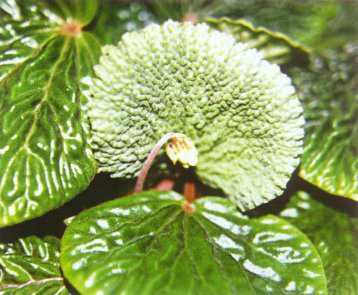B. crispula Brade is a Brazilian species described in 1950. Three to six inch orbicular, crinkled leaves grow at the ends of short, thin, creeping rhizomes. The leaves generally grow flat and tightly together in clusters of leaves. Petioles are one to two inches long, light cranberry in color, and are covered with very fine light colored hairs. Mature leaves are light to medium green in color and are covered with very fine light colored hairs that can be felt more easily than they can be seen. New leaves can be blue‑green or gray‑green. Light cranberry‑colored veins radiate from the site of the petiole attachment. The veins are raised on the back of the leaf, and depressed on the front, which contributes to the leaves’ puckered appearance.
Sparse flowers appear throughout the year on new growth. Flowers on my plant are less than one‑half inch in diameter. In natural light, in a north‑facing window, the peduncle is six to eight inches long and the flowers white. Under florescent lights the peduncle is five to six inches long and the flowers are white with faint pink coloration on the backs and centers of the tepals.
B. crispula needs high humidity to survive. In Virginia I grow it in a terrarium in well rinsed, cut sphagnum moss placed over a thin layer of perlite mixed with charcoal. After nine or ten months, the leaves begin to yellow and I know that it is time to change the moss. My plant grew well under florescent lights in our cool basement, but is also content to grow in a large terrarium situated in a north‑facing window. Our basement temperature ranges from fifty‑five degrees on a cool winter night to seventy‑five degrees in the summer.
Because of its tightly clustered,crinkled leaves, B. crispula should be watered very carefully to prevent leaf rot. I water only when the moss begins to dry out or when there is little or no condensation on the sides of the terrarium. I will occasionally use a very dilute fertilizer applied only to the moss. Pests and diseases are not often a problem in sealed terrariums. To prevent disease, remove dead leaves and spent blooms, and trim the leaves touching the sides of the terrarium. Since B. crispula leaves will not tolerate washing or spraying, combat pests by sealing a piece of a No Pest Strip or dog’s flea collar in the terrarium for several days.
To propagate, place a section of the rhizome or a leaf cutting, into cut, moistened sphagnum moss in an enclosed container under lights, or in with the mother plant, or start from seeds. Leaf wedges have decayed before rooting for me.
B. crispula may take a little extra effort to grow, but it is certainly worth that effort. It has been called finicky, delicate, difficult, even temperamental and a “Queen Bee”, [Kit Jeans Mounger]. If you are interested in a challenge, there will be leaves on the sale tables in OK.


